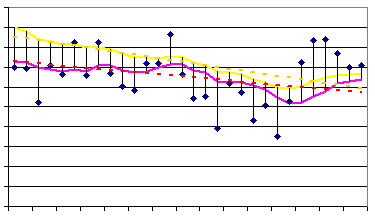Last weekend, I helped someone who needed a chart for a fantasy football league, to show the highest and lowest win/loss scores for each week. To help explain what it should look like, they posted a picture of a hand drawn chart, similar to the picture below.
After the chart is created, change the formatting so the gap is smaller, and the High and Low series have the colours that you want. In the screen shot below, you can see the chart that I created. If you want the actual High scores to appear, copy the Win High label and data (row 7), and Lose High label and data (row 11), and paste them into. In Excel 2016, charts and diagrams can show trends, averages, high and low points, and more. Not only do they make your worksheets more visually appealing, they also serve a definite function. They make it easier for your intended audience to sort out and understand the information you are presenting to them.
By the way, I created the sketch in Excel, by using the Marker option, in the Artistic Effects. Who knew that Excel was so artistically talented?
- The Volume-High-Low-Close Stock chart is also used to illustrate the stock prices. It requires four series of values in the following order: Volume, High, Low, and then Close. To create this chart, arrange the data in the order − Volume, High, Low, and Close. You can use the Volume-High-Low-Close Stock Chart to show the.
- In this video, we'll look at how to highlight high and low values in an Excel chart using data labels. This worksheet contains daily sales numbers for a small online store. I'll plot the data in a basic column chart. Let's say we want to highlight the highest and lowest values by showing these values directly over the bars.
- Under Chart Tools, on the Format tab, in the Current Selection group, click the arrow next to the Chart Elements box, and then click the chart element that you want to use. On the Format tab, in the Current Selection group, click Format Selection. In the Axis Options category, under Axis Options, select the Series in reverse order check box.
Set Up the Data

The win/loss data was set up with a separate column for each week, and rows for the win and loss highs and lows.
To create the type of chart that’s in the sketch, we’ll need to build a clustered stacked column chart. Blank rows and columns need to be added, and the numbers have to be staggered, with the Win and Loss numbers in separate columns.
The difference between the high and low scores needs to be calculated too, so the High amount is correctly shown. I also added a “W” or “L” heading to each column of scores, so the chart will be easier to understand.
Create the Chart
The yellow cells, in the screen shot above, are used as the source for the chart.

On the Ribbon’s Insert tab, click Column Chart, then click the Stacked Column option
After the chart is created, change the formatting so the gap is smaller, and the High and Low series have the colours that you want.
In the screen shot below, you can see the chart that I created.
If you want the actual High scores to appear, copy the Win High label and data (row 7), and Lose High label and data (row 11), and paste them into the chart. Then, change the 2 new series to Line Charts.
Then, add data labels to the Line Charts, to show the High scores, and add data labels at the Inside End for the Low scores.
Clustered Stacked Chart Utility
If you don't have the time or patience to arrange your data and create your own Clustered Stacked Column chart, Jon Peltier has an Excel Chart Utility. that will make the job easier for you.
You can see how it works in this video, or watch on YouTube: Create a Cluster Stack Chart With Excel Chart Utility
Download the Sample File
High Low Chart In Excel
To see how the data is set up, and view the completed chart, you can download the sample file from my Contextures website. On the Sample Excel Files page, go to the Charts section, and look for CH0010 - Show High and Low in Clustered Stacked Chart. The zipped file is in xlsx format, and does not contain macros.
High Low Average Chart In Excel
_________________________